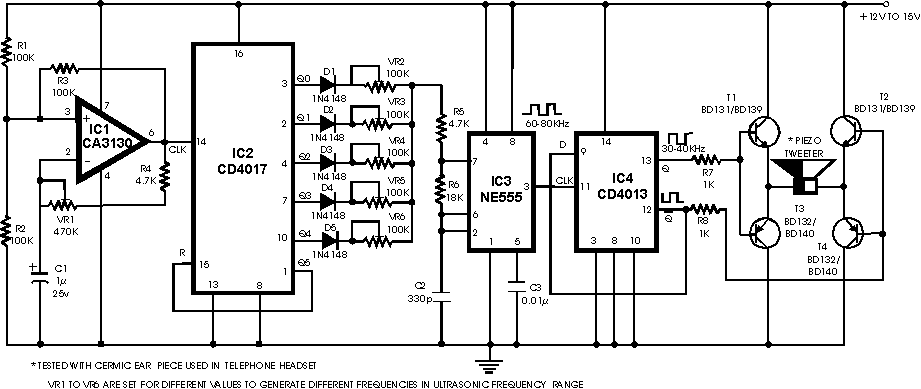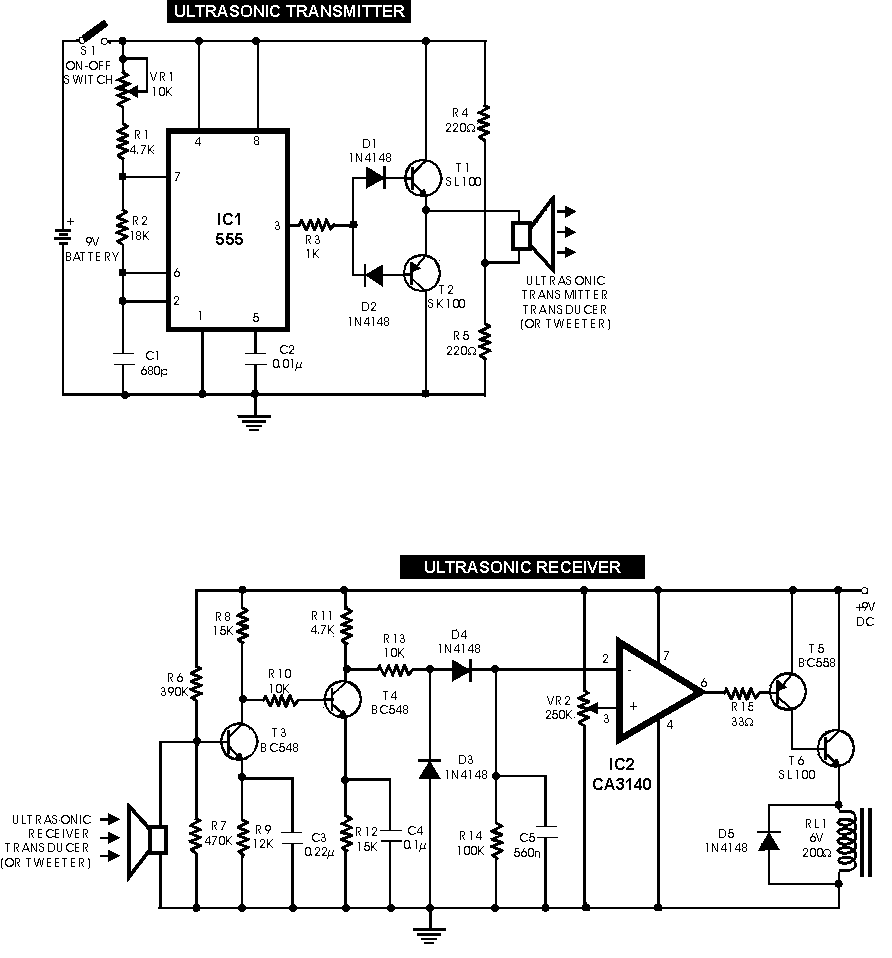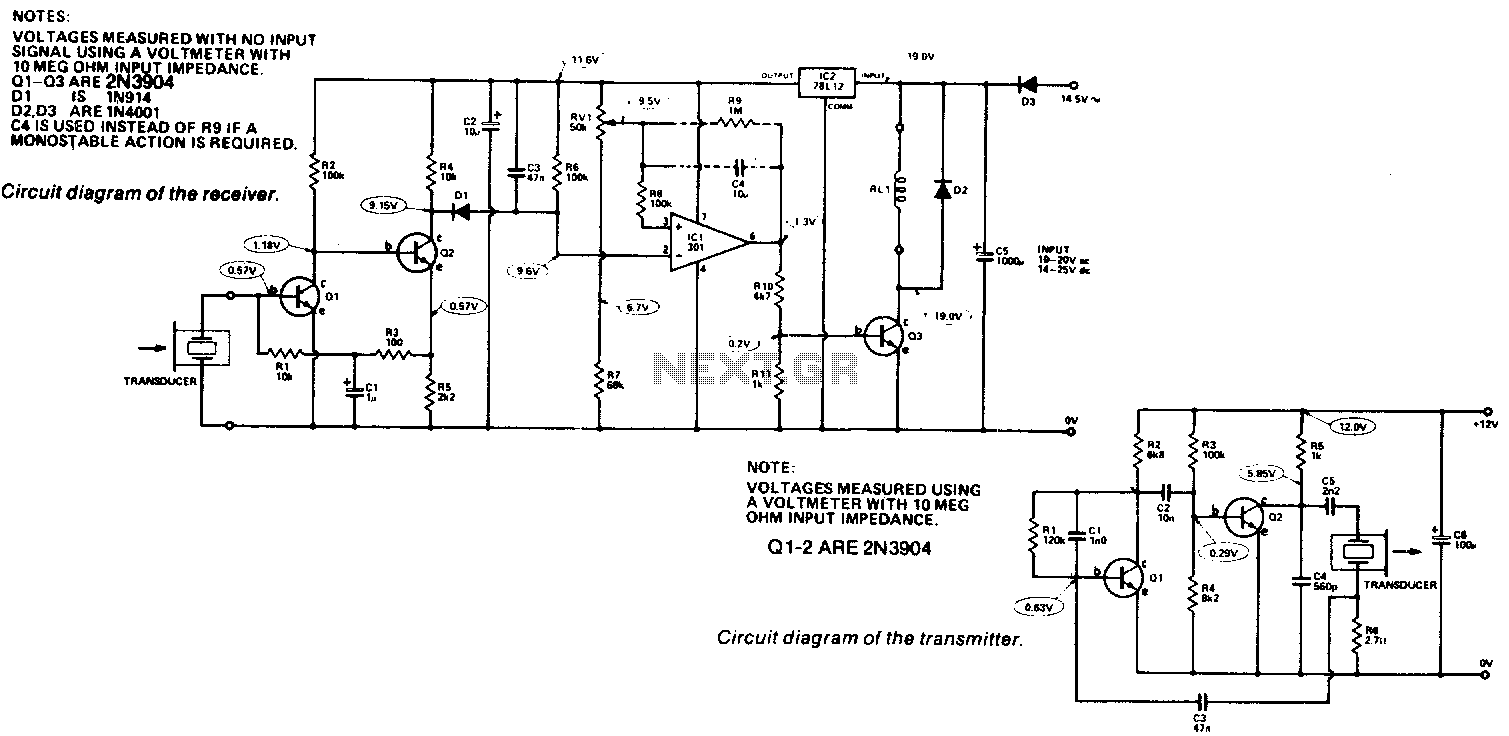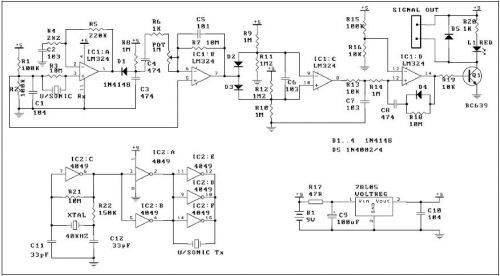
Ultrasonic bug-chaser

Low-intensity ultrasonic sound waves in the 30-45 kHz frequency band repel insects and small rodents. The unit is designed to generate a swept square wave from 30 to 45 kHz. The LM555 integrated circuit (IC) is configured as an ultrasonic oscillator driving a piezoelectric speaker of the high-fidelity super-tweeter type. The output of the oscillator is modulated by a 60 Hz signal from the AC input of the bridge rectifier. An LED serves as a pilot indicator.
The circuit operates by utilizing the LM555 timer IC, which is a versatile component commonly used in timing and oscillation applications. In this design, the LM555 is configured in astable mode to produce a square wave output that oscillates between 30 kHz and 45 kHz. The frequency sweeping is achieved by varying the timing components connected to the LM555, specifically the resistors and capacitors, which determines the charge and discharge times of the timing capacitor.
The output from the LM555 is fed into a piezoelectric speaker, which is capable of converting the electrical signals into ultrasonic sound waves. The choice of a high-fidelity super-tweeter ensures that the generated sound waves are of sufficient quality and intensity to effectively repel insects and small rodents without being audible to humans.
To enhance the functionality of the circuit, a bridge rectifier is included to convert the AC input voltage into a DC supply for the LM555. The 60 Hz signal derived from the AC input is used to modulate the frequency of the ultrasonic output, creating a sweeping effect that is more effective in deterring pests. The modulation adds an element of unpredictability to the sound waves, making it less likely for pests to acclimate to a constant frequency.
The circuit also includes an LED indicator, which provides a visual cue that the device is operational. This LED is typically connected in parallel with the power supply to the LM555, illuminating when the circuit is active. This feature is beneficial for users to easily verify the status of the unit.
Overall, this ultrasonic pest repeller circuit is designed to be efficient and effective, utilizing well-known electronic components to achieve its goal of repelling unwanted pests through the generation of ultrasonic sound waves.Low-intensity ultrasonic sound waves in the 30-45 kHz frequency band repel insects and small rodents. The unit is designed to generate a swept square wave from 30 to 45 kHz. The LM555 IC is wired as an ultrasonic oscillator driving a piezoelectric speaker of the hi-fi super-tweeter type
The output of the oscillator is swept by a 60-Hz signal from the ac input of the bridge rectifier. The LED acts as a pilot.
The circuit operates by utilizing the LM555 timer IC, which is a versatile component commonly used in timing and oscillation applications. In this design, the LM555 is configured in astable mode to produce a square wave output that oscillates between 30 kHz and 45 kHz. The frequency sweeping is achieved by varying the timing components connected to the LM555, specifically the resistors and capacitors, which determines the charge and discharge times of the timing capacitor.
The output from the LM555 is fed into a piezoelectric speaker, which is capable of converting the electrical signals into ultrasonic sound waves. The choice of a high-fidelity super-tweeter ensures that the generated sound waves are of sufficient quality and intensity to effectively repel insects and small rodents without being audible to humans.
To enhance the functionality of the circuit, a bridge rectifier is included to convert the AC input voltage into a DC supply for the LM555. The 60 Hz signal derived from the AC input is used to modulate the frequency of the ultrasonic output, creating a sweeping effect that is more effective in deterring pests. The modulation adds an element of unpredictability to the sound waves, making it less likely for pests to acclimate to a constant frequency.
The circuit also includes an LED indicator, which provides a visual cue that the device is operational. This LED is typically connected in parallel with the power supply to the LM555, illuminating when the circuit is active. This feature is beneficial for users to easily verify the status of the unit.
Overall, this ultrasonic pest repeller circuit is designed to be efficient and effective, utilizing well-known electronic components to achieve its goal of repelling unwanted pests through the generation of ultrasonic sound waves.Low-intensity ultrasonic sound waves in the 30-45 kHz frequency band repel insects and small rodents. The unit is designed to generate a swept square wave from 30 to 45 kHz. The LM555 IC is wired as an ultrasonic oscillator driving a piezoelectric speaker of the hi-fi super-tweeter type
The output of the oscillator is swept by a 60-Hz signal from the ac input of the bridge rectifier. The LED acts as a pilot.





